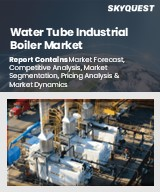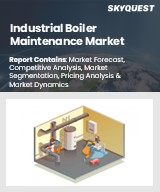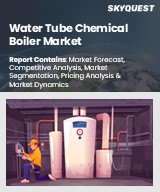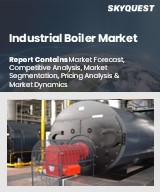
|
시장보고서
상품코드
1844293
코일 보일러 시장 : 시장 기회, 성장 촉진요인, 산업 동향 분석, 예측(2025-2034년)Coil Boiler Market Opportunity, Growth Drivers, Industry Trend Analysis, and Forecast 2025 - 2034 |
||||||
세계의 코일 보일러 시장 규모는 2024년에는 33억 달러로 평가되었고, CAGR 6.2%로 성장할 전망이며, 2034년에는 61억 달러에 이를 것으로 추정됩니다.

이 성장 궤도는 컴팩트하고 효율적이며 즉각적인 보일러 시스템에 대한 업계 선호도 증가를 반영합니다. 에너지 효율적인 솔루션에 대한 수요가 증가하고 환경 규제가 강화됨에 따라 기업은 시동 시간을 단축하고 연료 사용량을 최적화하는 코일 보일러 시스템으로 전환하고 있습니다. 이 시스템은 안정적이지만 유연한 증기 및 온수 생성이 필요한 산업에 특히 적합합니다. 연속 코일 설계는 저수를 최소화하고 열 전달을 가속화하기 위해 코일 보일러를 기존 모델을 대체하는 비용 효율성 및 공간 절약을 제공합니다. 연소 시스템, 배출 제어 및 모듈식 보일러 구성의 기술적 진보도 다양한 산업 분야에서 채택을 가속화하고 있습니다. 이동식 및 모듈식 유닛은 임시 운전 및 원격지 운전에 유연한 배치를 가능하게 하며, 자동화 및 지능형 제어 시스템은 성능 및 규정 준수 요구를 충족하는 데 필수적인 기능이 되었습니다. 북미, 특히 미국에서는 현대화 이니셔티브와 환경 기준이 보다 선진적인 저배출 보일러 솔루션으로 기존 설비를 업그레이드하도록 산업계를 뒷받침하고 있으며, 예측 기간 동안 코일 보일러 시장의 기세를 강화하고 있습니다.
| 시장 범위 | |
|---|---|
| 시작 연도 | 2024년 |
| 예측 연도 | 2025-2034년 |
| 시장 규모 | 33억 달러 |
| 예측 금액 | 61억 달러 |
| CAGR | 6.2% |
코일 보일러는 연속 코일 열교환기를 통해 증기 또는 온수를 생산하도록 설계되어 빠르고 직접적인 열 전달이 용이합니다. 쉘 앤 튜브식과 달리 코일식에서는 대량의 물을 필요로 하지 않기 때문에 기동 시간이 짧고 안정된 운전이 가능합니다. 코일 구성은 물이 열원에 직접 노출되는 사행 경로를 확실하게 흐르게 하므로 전체 공정이 빠르고 에너지 효율적입니다. 설비 면적을 확대하지 않고 생산을 최적화하는 것을 목표로 하는 산업계에서는 이러한 컴팩트한 모듈식 시스템의 매력이 꾸준히 높아지고 있습니다. 특히, 연소제어, 저NOx 배출, 운전효율 및 규제 준수를 위한 자동화에 중점을 둔 기술 혁신이 이 시장을 계속 형성하고 있습니다.
천연가스 연소 코일 보일러 시스템 분야는 2024년에는 52%의 점유율을 차지하였고, 2034년까지 CAGR 5.8%로 성장이 예측되고 있습니다. 이러한 시스템은 환경에 미치는 영향을 최소화하면서 성능 요구 사항을 충족할 수 있으므로 점점 더 선택되고 있습니다. 높은 열 효율과 변동하는 부하에 대한 대응 능력으로 알려진 가스 연소 코일 보일러는 보다 깨끗하고 반응성이 높은 열원을 요구하는 산업에서 널리 채택되고 있습니다. 기존 보일러에 비해 배출량이 적기 때문에 지속가능성과 규제의 무결성을 우선하는 기업에게 유리한 옵션이 되고 있습니다.
2024년 정격 290kW 이하 시스템의 코일 보일러 시장 규모는 3억 3,000만 달러로 평가되었습니다. 이 저용량 유닛은 설치의 용이성, 빠른 승온 능력 및 컴팩트한 설계를 평가합니다. 공간에 제약이 있는 산업이나 동적 열 수요가 있는 산업에서는 에너지 성능과 설치 면적 효율의 밸런스로 이 분야가 선호되는 경향이 있습니다. 생산 환경이 진화함에 따라, 특히 확장성과 신뢰성이 높은 솔루션을 추구하는 운영자들 사이에서 이러한 소용량 시스템에 대한 수요는 점차 증가하고 있습니다.
미국의 코일 보일러 2024년 시장 점유율은 84.3%로 평가되었고, 강력한 산업 기반, 적극적인 인프라 현대화 노력, 엄격한 배출 기준에 견인되어 5억 3,420만 달러를 창출했습니다. 에너지 절약에 대한 의식 증가와 컴플라이언스 규제 강화는 제조업체와 플랜트 운영자에게 첨단 코일 보일러 시스템의 도입을 촉구하고 있습니다. 시장 확대는 과거의 고출력 가스 보일러로부터 새로운 성능 벤치마크를 충족시킬 수 있는 보다 깨끗하고 효율적인 모델로의 전환에 의해 더욱 지원되고 있습니다.
코일 보일러 시장은 Bryan Steam, Bosch Industriekessel, Thermax, Babcock Wanson, Hurst Boiler & Welding, Ross Boilers, ALFA LAVAL, Unical AG, Vapor Power International, PARKER BOILER, Kawasaki Thermal Engineering, ICI Caldaie, NTI Boilers, Miura America, Cochran, CERTUSS, Ascentec, Maxtherm Boilers, Thermodyne Boilers, HTT ENERGY, Devotion Boiler, Rentech Boiler System, Forbes Marshall, Cannon Bono, Heat11, GekaKonus, Industrial Boilers, and Clayton Industries 등이 있습니다. 시장 포지션을 강화하기 위해 코일 보일러 업계의 기업은 몇 가지 고급 전략을 채택하고 있습니다. 연구개발에 대한 지속적인 투자는 에너지 효율성 향상, 배출량 감소, 지능형 제어 시스템 통합에 중점을 두고 여전히 우선순위를 유지하고 있습니다. 많은 기업은 다양한 용량 요구와 부하 프로파일을 수용하기 위해 제품 포트폴리오를 확대하고 있습니다.
목차
제1장 조사 방법 및 범위
제2장 주요 요약
제3장 업계 인사이트
- 생태계 분석
- 원재료 가용성 및 조달 분석
- 제조 능력 평가
- 공급망의 탄력성 및 위험 요인
- 배전망 해석
- 규제 상황
- 업계에 미치는 영향요인
- 성장 촉진요인
- 업계의 잠재적 위험 및 과제
- 성장 가능성 분석
- Porter's Five Forces 분석
- 공급기업의 협상력
- 구매자의 협상력
- 신규 참가업체의 위협
- 대체품의 위협
- PESTEL 분석
- 코일 보일러의 비용 구조 분석
- 가격 동향 분석(USD/단위)
- 지역별
- 용량별
- 새로운 기회 및 동향
- 디지털화 및 IoT의 통합
- 신흥 시장에 대한 침투
- 투자 분석 및 미래 전망
- 전략 시나리오 계획
- 투자 기회 평가
- 전략적 파트너십 및 제휴의 기회
- 시장 진출 전략적 틀
제4장 경쟁 구도
- 서문
- 기업의 시장 점유율 분석 : 지역별
- 북미
- 유럽
- 아시아태평양
- 중동 및 아프리카
- 라틴아메리카
- 전략적 대시보드
- 전략적 노력
- 주요 파트너십 및 협업
- 주요 M&A 활동
- 제품의 혁신 및 발매
- 시장 확대 전략
- 경쟁 벤치마킹
- 혁신 및 지속가능성의 정세
제5장 시장 규모 및 예측 : 연료별(2021-2034년)
- 주요 동향
- 천연가스
- 기름
- 전기
- 신재생 에너지
- 듀얼 연료
- 기타
제6장 시장 규모 및 예측 : 최종 용도별(2021-2034년)
- 주요 동향
- 뜨거운 물
- 스팀
- 열유체
제7장 시장 규모 및 예측 : 용도별(2021-2034년)
- 주요 동향
- 식품 및 음료
- 화학 약품
- 제약 및 병원
- 펄프 및 종이
- 금속 가공
- 섬유
- 유지 정제
- 기타
제8장 시장 규모 및 예측 : 용량별(2021-2034년)
- 주요 동향
- 290kW 이하
- 290kW 이상-1.5MW 이상
- 1.5MW-3MW 이상
- 3MW-15MW 이상
- 15MW 이상
제9장 시장 규모 및 예측 : 압력별(2021-2034년)
- 주요 동향
- 10바 미만
- 10바 이상-25바
- 25바 이상
제10장 시장 규모 및 예측 : 설비별(2021-2034년)
- 주요 동향
- 그린필드
- 브라운필드
제11장 시장 규모 및 예측 : 지역별(2021-2034년)
- 주요 동향
- 북미
- 미국
- 캐나다
- 멕시코
- 유럽
- 프랑스
- 영국
- 폴란드
- 이탈리아
- 스페인
- 오스트리아
- 독일
- 스웨덴
- 노르웨이
- 덴마크
- 핀란드
- 아일랜드
- 우크라이나
- 아시아태평양
- 중국
- 인도
- 필리핀
- 일본
- 한국
- 북한
- 호주
- 인도네시아
- 파키스탄
- 방글라데시
- 베트남
- 대만
- 홍콩
- 카자흐스탄
- 태국
- 말레이시아
- 싱가포르
- 우즈베키스탄
- 중동 및 아프리카
- 사우디아라비아
- 이란
- 아랍에미리트(UAE)
- 이집트
- 나이지리아
- 케냐
- 모로코
- 남아프리카
- 튀니지
- 알제리
- 튀르키예
- 아랍 공화국
- 요르단
- 이라크
- 라틴아메리카
- 아르헨티나
- 칠레
- 브라질
- 콜롬비아
제12장 기업 프로파일
- ALFA LAVAL
- Ascentec GmbH
- Babcock Wanson
- Bosch Industriekessel
- Bryan Steam
- Cannon Bono SpA
- CERTUSS
- Clayton Industries
- Cochran
- Devotion Boiler
- Forbes Marshall
- Fulton
- GekaKonus
- Heat11
- HTT ENERGY GMBH
- Hurst Boiler & Welding Co.
- ICI Caldaie
- Industrial Boilers Ltd.
- Kawasaki Thermal Engineering Co., Ltd.
- Maxtherm Boilers
- Miura America Co.
- NTI Boilers
- PARKER BOILER
- Rentech Boiler System
- Ross Boilers
- SAZ BOILERS
- Thermax
- Thermodyne Boilers
The Global Coil Boiler Market was valued at USD 3.3 billion in 2024 and is estimated to grow at a CAGR of 6.2% to reach USD 6.1 billion by 2034.
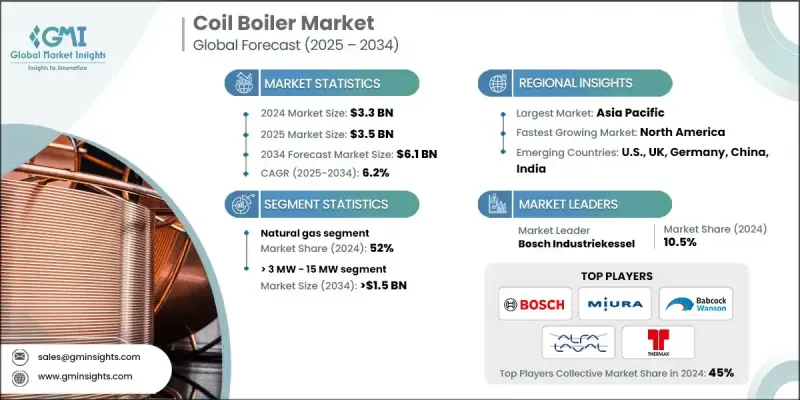
This growth trajectory reflects the industry's increasing preference for compact, efficient, and quick-response boiler systems. With rising demand for energy-efficient solutions and stricter environmental regulations, businesses are shifting toward coil boiler systems that reduce startup time and optimize fuel usage. These systems are particularly well-suited for industries requiring consistent but flexible steam or hot water generation. The continuous coil design minimizes water storage and speeds up heat transfer, making coil boilers a cost-effective and space-saving alternative to traditional models. Technological advancements in combustion systems, emissions control, and modular boiler configurations are also accelerating adoption across various industrial sectors. Mobile and modular units are enabling flexible deployment for temporary and remote operations, while automation and intelligent control systems are becoming integral features to meet performance and compliance needs. In North America, especially the U.S., modernization initiatives and environmental standards are pushing industries to upgrade legacy equipment with more advanced, low-emission boiler solutions, reinforcing the coil boiler market's momentum over the forecast period.
| Market Scope | |
|---|---|
| Start Year | 2024 |
| Forecast Year | 2025-2034 |
| Start Value | $3.3 Billion |
| Forecast Value | $6.1 Billion |
| CAGR | 6.2% |
A coil boiler is designed to produce steam or hot water through a continuous coil heat exchanger that facilitates fast, direct heat transfer. Unlike shell-and-tube systems, the coil-based approach eliminates the need for large water volumes, allowing quicker start-up times and more consistent operation. The coil configuration ensures water flows through a serpentine path exposed directly to a heat source, making the entire process faster and more energy-efficient. As industries aim to optimize production without expanding facility footprints, the appeal of these compact and modular systems is growing steadily. Technological enhancements continue to shape this market, particularly innovations focused on combustion control, low-NOx emissions, and automation for operational efficiency and regulatory compliance.
The natural gas-fired coil boiler systems segment held a 52% share in 2024 and is forecasted to grow at a CAGR of 5.8% through 2034. These systems are increasingly selected for their ability to meet performance requirements with minimal environmental impact. Known for their high thermal efficiency and ability to handle fluctuating loads, gas-fired coil boilers are widely adopted in industries seeking a cleaner, more responsive heat source. The lower emissions profile compared to conventional boilers makes them a favorable option for businesses prioritizing sustainability and regulatory alignment.
In 2024, the coil boiler market for systems rated <= 290 kW generated USD 330 million. These lower-capacity units are valued for their ease of installation, fast heat-up capabilities, and compact design. Industries with constrained space or dynamic heat demands tend to favor this segment for its balance of energy performance and footprint efficiency. As production environments evolve, demand for these smaller capacity systems continues to rise, especially among operators looking for scalable and reliable solutions.
U.S. Coil Boiler Market held 84.3% share in 2024, generating USD 534.2 million driven by a strong industrial base, aggressive infrastructure modernization efforts, and tighter emission standards. Growing awareness around energy conservation and stricter compliance regulations are motivating manufacturers and plant operators to adopt advanced coil boiler systems. Market expansion is further supported by the shift from outdated, high-emission boilers to cleaner, more efficient models capable of meeting new performance benchmarks.
The coil boiler market features a broad mix of industry leaders and emerging players, including Bryan Steam, Bosch Industriekessel, Thermax, Babcock Wanson, Hurst Boiler & Welding, Ross Boilers, ALFA LAVAL, Unical AG, Vapor Power International, PARKER BOILER, Kawasaki Thermal Engineering, ICI Caldaie, NTI Boilers, Miura America, Cochran, CERTUSS, Ascentec, Maxtherm Boilers, Thermodyne Boilers, HTT ENERGY, Devotion Boiler, Rentech Boiler System, Forbes Marshall, Cannon Bono, Heat11, GekaKonus, Industrial Boilers, and Clayton Industries. To strengthen their market position, companies in the coil boiler industry are adopting several forward-focused strategies. Continuous investment in R&D remains a priority, with a focus on improving energy efficiency, reducing emissions, and integrating intelligent control systems. Many players are expanding their product portfolios to cater to varying capacity needs and load profiles.
Table of Contents
Chapter 1 Methodology & Scope
- 1.1 Research design
- 1.1.1 Research approach
- 1.1.2 Data collection methods
- 1.2 Base estimates and calculations
- 1.2.1 Base year calculation
- 1.2.2 Market estimates & forecast parameters
- 1.3 Forecast model
- 1.3.1 Key trends for market estimates
- 1.3.2 Quantified market impact analysis
- 1.3.2.1 Mathematical impact of growth parameters on forecast
- 1.3.3 Scenario analysis framework
- 1.4 Primary research and validation
- 1.4.1 Some of the primary sources (but not limited to)
- 1.5 Data mining sources
- 1.5.1 Paid Sources
- 1.5.2 Sources, by region
- 1.6 Research trail & scoring components
- 1.6.1 Research trail components
- 1.6.2 Scoring components
- 1.7 Research transparency addendum
- 1.7.1 Source attribution framework
- 1.7.2 Quality assurance metrics
- 1.7.3 Our commitment to trust
- 1.8 Market definitions
Chapter 2 Executive Summary
- 2.1 Industry synopsis, 2021 - 2034
Chapter 3 Industry Insights
- 3.1 Industry ecosystem analysis
- 3.1.1 Raw material availability & sourcing analysis
- 3.1.2 Manufacturing capacity assessment
- 3.1.3 Supply chain resilience & risk factors
- 3.1.4 Distribution network analysis
- 3.2 Regulatory landscape
- 3.3 Industry impact forces
- 3.3.1 Growth drivers
- 3.3.2 Industry pitfalls & challenges
- 3.4 Growth potential analysis
- 3.5 Porter's analysis
- 3.5.1 Bargaining power of suppliers
- 3.5.2 Bargaining power of buyers
- 3.5.3 Threat of new entrants
- 3.5.4 Threat of substitutes
- 3.6 PESTEL analysis
- 3.6.1 Political factors
- 3.6.2 Economic factors
- 3.6.3 Social factors
- 3.6.4 Technological factors
- 3.6.5 Legal factors
- 3.6.6 Environmental factors
- 3.7 Cost structure analysis of coil boilers
- 3.8 Price trend analysis (USD/Unit)
- 3.8.1 By region
- 3.8.2 By capacity
- 3.9 Emerging opportunities & trends
- 3.9.1 Digitalization & IoT integration
- 3.9.2 Emerging market penetration
- 3.10 Investment analysis & future prospects
- 3.11 Strategic scenario planning
- 3.12 Investment opportunity assessment
- 3.13 Strategic partnership & alliance opportunities
- 3.14 Market entry strategy framework
Chapter 4 Competitive Landscape, 2025
- 4.1 Introduction
- 4.2 Company market share analysis, by region, 2024
- 4.2.1 North America
- 4.2.2 Europe
- 4.2.3 Asia Pacific
- 4.2.4 Middle East & Africa
- 4.2.5 Latin America
- 4.3 Strategic dashboard
- 4.4 Strategic initiatives
- 4.4.1 Key partnerships & collaborations
- 4.4.2 Major M&A activities
- 4.4.3 Product innovations & launches
- 4.4.4 Market expansion strategies
- 4.5 Competitive benchmarking
- 4.6 Innovation & sustainability landscape
Chapter 5 Market Size and Forecast, By Fuel, 2021 - 2034 (USD Million & Units)
- 5.1 Key trends
- 5.2 Natural gas
- 5.3 Oil
- 5.4 Electric
- 5.5 Renewables
- 5.6 Dual fuel
- 5.7 Others
Chapter 6 Market Size and Forecast, By End Use, 2021 - 2034 (USD Million & Units)
- 6.1 Key trends
- 6.2 Hot water
- 6.3 Steam
- 6.4 Thermal fluid
Chapter 7 Market Size and Forecast, By Application, 2021 - 2034 (USD Million & Units)
- 7.1 Key trends
- 7.2 Food & beverage
- 7.3 Chemical
- 7.4 Pharmaceutical & hospital
- 7.5 Pulp & paper
- 7.6 Metal processing
- 7.7 Textile
- 7.8 Oil & fats refining
- 7.9 Others
Chapter 8 Market Size and Forecast, By Capacity, 2021 - 2034 (USD Million & Units)
- 8.1 Key trends
- 8.2 ≤ 290 kW
- 8.3 > 290 kW - 1.5 MW
- 8.4 > 1.5 MW - 3 MW
- 8.5 > 3 MW - 15 MW
- 8.6 > 15 MW
Chapter 9 Market Size and Forecast, By Pressure, 2021 - 2034 (USD Million & Units)
- 9.1 Key trends
- 9.2 ≤ 10 bar
- 9.3 > 10 bar - 25 bar
- 9.4 > 25 bar
Chapter 10 Market Size and Forecast, By Installation, 2021 - 2034 (USD Million & Units)
- 10.1 Key trends
- 10.2 Greenfield
- 10.3 Brownfield
Chapter 11 Market Size and Forecast, By Region, 2021 - 2034 (USD Million & Units)
- 11.1 Key trends
- 11.2 North America
- 11.2.1 U.S.
- 11.2.2 Canada
- 11.2.3 Mexico
- 11.3 Europe
- 11.3.1 France
- 11.3.2 UK
- 11.3.3 Poland
- 11.3.4 Italy
- 11.3.5 Spain
- 11.3.6 Austria
- 11.3.7 Germany
- 11.3.8 Sweden
- 11.3.9 Norway
- 11.3.10 Denmark
- 11.3.11 Finland
- 11.3.12 Ireland
- 11.3.13 Ukraine
- 11.4 Asia Pacific
- 11.4.1 China
- 11.4.2 India
- 11.4.3 Philippines
- 11.4.4 Japan
- 11.4.5 South Korea
- 11.4.6 North Korea
- 11.4.7 Australia
- 11.4.8 Indonesia
- 11.4.9 Pakistan
- 11.4.10 Bangladesh
- 11.4.11 Vietnam
- 11.4.12 Taiwan
- 11.4.13 Hong Kong
- 11.4.14 Kazakhstan
- 11.4.15 Thailand
- 11.4.16 Malaysia
- 11.4.17 Singapore
- 11.4.18 Uzbekistan
- 11.5 Middle East & Africa
- 11.5.1 Saudi Arabia
- 11.5.2 Iran
- 11.5.3 UAE
- 11.5.4 Egypt
- 11.5.5 Nigeria
- 11.5.6 Kenya
- 11.5.7 Morocco
- 11.5.8 South Africa
- 11.5.9 Tunisia
- 11.5.10 Algeria
- 11.5.11 Turkey
- 11.5.12 Arab Republic
- 11.5.13 Jordan
- 11.5.14 Iraq
- 11.6 Latin America
- 11.6.1 Argentina
- 11.6.2 Chile
- 11.6.3 Brazil
- 11.6.4 Colombia
Chapter 12 Company Profiles
- 12.1 ALFA LAVAL
- 12.2 Ascentec GmbH
- 12.3 Babcock Wanson
- 12.4 Bosch Industriekessel
- 12.5 Bryan Steam
- 12.6 Cannon Bono S.p.A.
- 12.7 CERTUSS
- 12.8 Clayton Industries
- 12.9 Cochran
- 12.10 Devotion Boiler
- 12.11 Forbes Marshall
- 12.12 Fulton
- 12.13 GekaKonus
- 12.14 Heat11
- 12.15 HTT ENERGY GMBH
- 12.16 Hurst Boiler & Welding Co.
- 12.17 ICI Caldaie
- 12.18 Industrial Boilers Ltd.
- 12.19 Kawasaki Thermal Engineering Co., Ltd.
- 12.20 Maxtherm Boilers
- 12.21 Miura America Co.
- 12.22 NTI Boilers
- 12.23 PARKER BOILER
- 12.24 Rentech Boiler System
- 12.25 Ross Boilers
- 12.26 SAZ BOILERS
- 12.27 Thermax
- 12.28 Thermodyne Boilers






